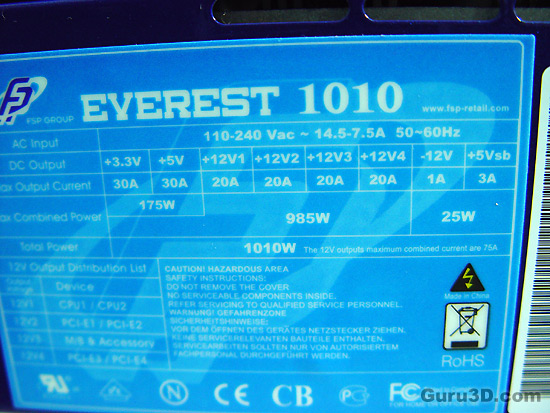Page 2 - Specs
Let's dive into the color blue, the Everest 1010.
The FSP group released this power supply with the statement that it will not only have a huge amount of power across all rails, but does so with acceptable noise levels. Built under SKU name 'PPA9800100' we can say it has okay aesthetics, which we'll show you later on in our photo-shoot. A 1010 Watts ready for Quad GFX solutions and multi-core (server) systems. The PSU itself is build in accordance with ATX12V Version 2.2 and EPS12V Version 2.91, including 8-pin 12V connection specification.
If we look closer at the voltage rails for a minute, we see there's nothing to complain about. There's enough overall juice for anything in your rig no-matter how high-end it is, yet focus on the important 12 Volts rails. There are four +12V circuits. You get to play around with four PCIe connectors for your graphics cards (2x PCI-E 2.0 6+2-pin (150 Watt) & 2x PCI-E 1.0 6-pin (75 Watt). These four separate 12V circuits each are rated with a 20A maximum peak load to ensure the stable distribution of the power requirements of your high-end gear. There's no mention of the combined 12v load power though.
To get you a broader overview, one GeForce 8800 GTX draws roughly 9A maximum.

Two 6+2-pin PCI-E II connectors and two 6-pin PCI-E connectors are provided for SLI and Crossfire graphics cards. The PSU is SLI certified by NVIDIA, yet does not show up at NV's SLI Zone. Also a notable feature, the PSU is covered by a three year warranty.
You'll have loads of connectivity:
- 1 x Main connector (20+4Pin)
- 1 x 12V(P4)
- 1 x 12V(4+4Pin)
- 6 x peripheral
- 9 x SATA
- 1 x Floppy
- 2 x PCI-E (6Pin)
- 2 x PCI-E (6+2Pin)
Yep, gotta like that power offering modular design. Here are some specifics
|
Efficiency |
85% | |
|
Input Voltage |
110-240 VAC | |
|
Frequency |
50Hz - 60Hz | |
|
PFC |
Active | |
|
Power Provided |
1010W | |
|
Over-Current Protection |
V | |
|
Over-Voltage Protection |
V | |
|
Short-Circuit Protection |
V | |
|
Line Type |
Main connector |
20+4Pin |
|
4Pin+12V Power Connector |
1 | |
|
4Pin Floppy Connector |
2 | |
|
S-ATA Connector |
9 | |
|
4Pin Connector |
6 | |
|
(6&8)Pin PCI-Express Connector |
2 | |
|
Case Color |
Blue | |
|
Chassis Fan |
- | |
|
Noise |
<30 dBA | |
|
Form Factor |
Intel ATX12V V2.2 & EPS12V V2.91 | |
|
Safety Approval |
UL, CB, CE, VDE, Nemko, FCC, C-TICK, BSMI, GOST | |
|
Dimensions(LxWxH)mm |
140*150*86 | |
Power Efficiency
Judging from the specs the power efficiency of PSU is is nothing to be ashamed about either as it is rated at 85% Measured at 230V (which we use here in Europe).
But what does that mean? The Power Efficiency of a power supply?
First and foremost; the higher the better, efficiency is good.
When power is drawn from your wall socket and travels into your power supply, not all of it is transformed into electricity that your computer consumes. A rather large part of that current will get lost as there is heat that is dissipating in the capacitors or leakage in circuits and other insufficiencies. So it boils down to this: If your computer requires 500 watts of power, a power supply will draw more than that from your electric company. Here's an example:
If you have a generic power supply with an average 70% efficiency a 350 power draw (350/70x100) watt load would mean it is drawing 500 watts of current from your wall socket while your PC only uses 350 watts, interesting eh?
Let's do that math again , yet this time with a 80% power efficiency in mind: 350/80x100= 437 Watt. So that's saving 63 Watts over a 70% efficient product. If you have your PC powered on a lot , think about this theory and what it can save you in the long term.
Not this PSU has 85% efficiency 350/85x100=412 Watt. We could save 88 Watts by just choosing a better power supply. The higher the efficiency the less power loss, the less money you have to pay. And hey ... it's good for mother nature as well. I find energy efficiency one of the most important developments in a PSU this and coming year, we'll monitor this closely.
So next to being a really capable, this is an efficient PSU.
Active PFC
This model has a very nice feature called Active PFC. To put it in simple terms, Active PFC PSUs are more expensive and, from a power consumption point of view, more efficient. Power Factor Correction (PFC) allows power distribution to operate at its highest efficiency. There are two types of PFC, Active PFC and Passive PFC. This PSU has Active PFC. Active PFC uses a circuit to correct power factor, Active PFC is able to generate a theoretical power factor of over 95%. Active Power Factor Correction also markedly diminishes total harmonics, automatically corrects for AC input voltage, and is capable of a full range of input voltage. Since Active PFC is the more complex method of Power Factor Correction, it is definitely more expensive to produce an Active PFC power supply.
WarrantyThe PSU has a 3 year warranty which is an reasonable amount of warranty and 1 year more than legally required. Alright ... let's have a look at the photo shoot followed by some testing.
